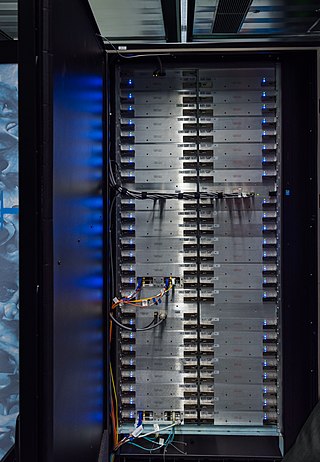Related Research Articles

A supercomputer is a computer with a high level of performance as compared to a general-purpose computer. The performance of a supercomputer is commonly measured in floating-point operations per second (FLOPS) instead of million instructions per second (MIPS). Since 2017, there have existed supercomputers which can perform over 1017 FLOPS (a hundred quadrillion FLOPS, 100 petaFLOPS or 100 PFLOPS). For comparison, a desktop computer has performance in the range of hundreds of gigaFLOPS (1011) to tens of teraFLOPS (1013). Since November 2017, all of the world's fastest 500 supercomputers run on Linux-based operating systems. Additional research is being conducted in the United States, the European Union, Taiwan, Japan, and China to build faster, more powerful and technologically superior exascale supercomputers.

In computing, floating point operations per second is a measure of computer performance, useful in fields of scientific computations that require floating-point calculations. For such cases, it is a more accurate measure than measuring instructions per second.

Blue Gene is an IBM project aimed at designing supercomputers that can reach operating speeds in the petaFLOPS (PFLOPS) range, with low power consumption.

The Indian Institute of Tropical Meteorology (IITM) is a scientific institution based in Pune, Maharashtra, India for expanding research in the tropical Indian Ocean with special reference to monsoon meteorology, and air-sea interaction of South Asian climate. It is an Autonomous Institute of the Ministry of Earth Sciences, Government of India.

The TOP500 project ranks and details the 500 most powerful non-distributed computer systems in the world. The project was started in 1993 and publishes an updated list of the supercomputers twice a year. The first of these updates always coincides with the International Supercomputing Conference in June, and the second is presented at the ACM/IEEE Supercomputing Conference in November. The project aims to provide a reliable basis for tracking and detecting trends in high-performance computing and bases rankings on HPL, a portable implementation of the high-performance LINPACK benchmark written in Fortran for distributed-memory computers.

IBM Sequoia was a petascale Blue Gene/Q supercomputer constructed by IBM for the National Nuclear Security Administration as part of the Advanced Simulation and Computing Program (ASC). It was delivered to the Lawrence Livermore National Laboratory (LLNL) in 2011 and was fully deployed in June 2012. Sequoia was dismantled in 2020, its last position on the top500.org list was #22 in the November 2019 list.

Tianhe-I, Tianhe-1, or TH-1 is a supercomputer capable of an Rmax of 2.5 peta FLOPS. Located at the National Supercomputing Center of Tianjin, China, it was the fastest computer in the world from October 2010 to June 2011 and was one of the few petascale supercomputers in the world.
Exascale computing refers to computing systems capable of calculating at least "1018 IEEE 754 Double Precision (64-bit) operations (multiplications and/or additions) per second (exaFLOPS)"; it is a measure of supercomputer performance.
Tera 100 is a supercomputer built by Bull SA for the French Commissariat à l'Énergie Atomique.

The K computer – named for the Japanese word/numeral "kei" (京), meaning 10 quadrillion (1016) – was a supercomputer manufactured by Fujitsu, installed at the Riken Advanced Institute for Computational Science campus in Kobe, Hyōgo Prefecture, Japan. The K computer was based on a distributed memory architecture with over 80,000 compute nodes. It was used for a variety of applications, including climate research, disaster prevention and medical research. The K computer's operating system was based on the Linux kernel, with additional drivers designed to make use of the computer's hardware.

Several centers for supercomputing exist across Europe, and distributed access to them is coordinated by European initiatives to facilitate high-performance computing. One such initiative, the HPC Europa project, fits within the Distributed European Infrastructure for Supercomputing Applications (DEISA), which was formed in 2002 as a consortium of eleven supercomputing centers from seven European countries. Operating within the CORDIS framework, HPC Europa aims to provide access to supercomputers across Europe.

Titan or OLCF-3 was a supercomputer built by Cray at Oak Ridge National Laboratory for use in a variety of science projects. Titan was an upgrade of Jaguar, a previous supercomputer at Oak Ridge, that uses graphics processing units (GPUs) in addition to conventional central processing units (CPUs). Titan was the first such hybrid to perform over 10 petaFLOPS. The upgrade began in October 2011, commenced stability testing in October 2012 and it became available to researchers in early 2013. The initial cost of the upgrade was US$60 million, funded primarily by the United States Department of Energy.
The PRIMEHPC FX10 is a supercomputer designed and manufactured by Fujitsu. Announced on 7 November 2011 at the Supercomputing Conference, the PRIMEHPC FX10 is an improved and commercialized version of the K computer, which was the first supercomputer to obtain more than 10 PFLOPS on the LINPACK benchmark. In its largest configuration, the PRIMEHPC FX10 has a peak performance 23.2 PFLOPS, power consumption of 22.4 MW, and a list price of US$655.4 million. It was succeeded by the PRIMEHPC FX100 with SPARC64 XIfx processors in 2015.
Cycle Computing is a company that provides software for orchestrating computing and storage resources in cloud environments. The flagship product is CycleCloud, which supports Amazon Web Services, Google Compute Engine, Microsoft Azure, and internal infrastructure. The CycleCloud orchestration suite manages the provisioning of cloud infrastructure, orchestration of workflow execution and job queue management, automated and efficient data placement, full process monitoring and logging, within a secure process flow.

The Cray XC40 is a massively parallel multiprocessor supercomputer manufactured by Cray. It consists of Intel Haswell Xeon processors, with optional Nvidia Tesla or Intel Xeon Phi accelerators, connected together by Cray's proprietary "Aries" interconnect, stored in air-cooled or liquid-cooled cabinets. The XC series supercomputers are available with the Cray DataWarp applications I/O accelerator technology.
Prathyushand Mihir are the supercomputers established at Indian Institute of Tropical Meteorology (IITM), Pune and National Centre for Medium Range Weather Forecast (NCMRWF), Noida respectively. As of January 2018, Prathyush and Mihir are the fastest supercomputer in India with a maximum speed of 6.8 PetaFlops at a total cost of INR 438.9 Crore. The system was inaugurated by Dr. Harsh Vardhan, Union Minister for science and technology, on 8 January 2018.The word 'Pratyush' defines the rising sun.

The European High-Performance Computing Joint Undertaking is a public-private partnership in High Performance Computing (HPC), enabling the pooling of European Union–level resources with the resources of participating EU Member States and participating associated states of the Horizon Europe and Digital Europe programmes, as well as private stakeholders. The Joint Undertaking has the twin stated aims of developing a pan-European supercomputing infrastructure, and supporting research and innovation activities. Located in Luxembourg City, Luxembourg, the Joint Undertaking started operating in November 2018 under the control of the European Commission and became autonomous in 2020.

Fugaku(Japanese: 富岳) is a petascale supercomputer at the Riken Center for Computational Science in Kobe, Japan. It started development in 2014 as the successor to the K computer and made its debut in 2020. It is named after an alternative name for Mount Fuji.
The A64FX is a 64-bit ARM architecture microprocessor designed by Fujitsu. The processor is replacing the SPARC64 V as Fujitsu's processor for supercomputer applications. It powers the Fugaku supercomputer, the fastest supercomputer in the world by TOP500 rankings as of June 2020 as well as November 2020, June 2021 and November 2021.
Aurora is a planned supercomputer to be completed in 2023. It will be the United States' second exascale computer after the AMD-powered Frontier-supercomputer. It is sponsored by the United States Department of Energy (DOE) and designed by Intel and Cray for the Argonne National Laboratory. It will have c. 2 exaFLOPS in computing power which is approximately a quintillion (260 or 1018) calculations per second and will have an expected cost of US$500 million. It will follow Frontier, which was the world's first exascale supercomputer in 2022.
References
- ↑ AI Bridging Cloud Infrastructure (ABCI) itri.aist.go.jp Retrieved 26 May 2023
- ↑ Russell, John (10 October 2017). "Fujitsu Tapped to Build 37-Petaflops ABCI System for AIST". HPC Wire. Retrieved 23 October 2017.
- 1 2 David, Eric (25 November 2016). "Japan plans to build the fastest deep learning supercomputer". Silicon Angle. Retrieved 25 November 2016.
- ↑ Moody, Glyn (25 November 2016). "Japan plans 130-petaflop China-beating number-crunching supercomputer". Ars Technica . Retrieved 25 November 2016.
- ↑ Sayer, Peter (25 November 2016). "Japan aims for superefficient supercomputer by 2017". Computer World. Retrieved 25 November 2016.
- ↑ Doran, Temujin; Scott, Katy (31 July 2017). "Japan is building the fastest supercomputer ever made". CNN. Retrieved 7 November 2017.
- 1 2 Jones, Rhett (26 November 2016). "Japan Throws Down The Gauntlet With Plan For World's Fastest Supercomputer". Gizmodo. Retrieved 25 November 2016.
- ↑ Feldman, Michael (2017-10-11). "Fujitsu to Build Japan's Fastest Supercomputer". top500.org. Archived from the original on 2017-10-11. Retrieved 2017-11-07.
- ↑ Moss, Sebastian (10 October 2017). "Fujitsu to build Japan's fastest supercomputer for AIST". Data Centre Dynamics. Retrieved 17 August 2019.
- ↑ Brueckner, Rich (25 November 2016). "Japan to Build 130 Petaflop ABCI Supercomputer". InsideHPC. Retrieved 25 November 2016.